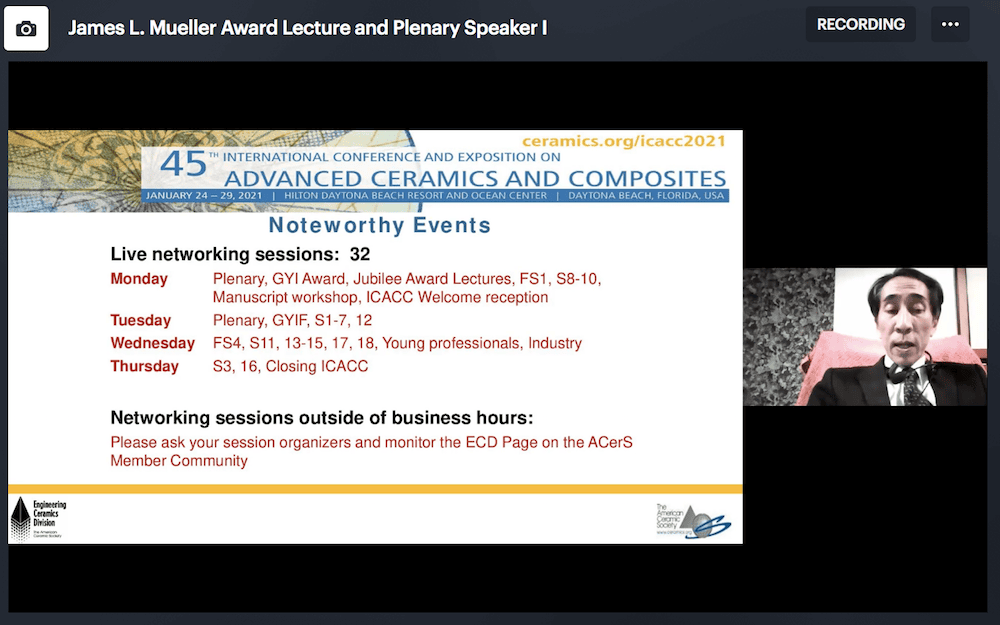
[Image above] Engineering Ceramics Division chair-elect and ICACC program chair Hisayuki Suematsu welcomes everyone to the conference on Feb. 8, 2021, and outlines noteworthy events taking place over the course of the week. Credit: ACerS
The 45th International Conference and Expo on Advanced Ceramics and Composites (ICACC 2021), which usually takes place in Daytona Beach, Fla., was held virtually last week on February 8–11. ICACC may be ACerS’ second virtual conference for the year after EMA 2021, but it comes in first place for number of attendees.
Excluding MS&T20, which ACerS co-hosted with two other societies, ICACC 2021 had the largest number of attendees for a virtual conference to date. The week-long conference welcomed 836 attendees, including 236 students, from 41 countries to participate in 18 symposia and four focused sessions, which featured over 680 submitted abstracts. Thirty-two live networking sessions also took place between sessions.
Below are some highlights from virtual ICACC 2021.
Plenaries and award lectures: Covering the gamut of advanced ceramic applications
When ICACC is held in-person, the conference typically kicks off on Monday morning with four big talks: two plenary speakers and the James L. Mueller Award and Bridge Building Award lectures. This year, because of the virtual format, the plenaries and awards were split across Monday and Tuesday morning.
On Monday, University of California, Davis Distinguished Professor Emeritus Zuhair Munir gave the Mueller Award lecture on the role of electric field effects in the processing of materials. His presentation was followed by plenary speaker Julia Greer, Ruben F. and Donna Mettler professor of materials science, mechanics, and medical engineering and director of the Kavli Nanoscience Institute at the California Institute of Technology, who discussed her group’s research on creating 3D nanoarchitected metamaterials.
On Tuesday, Politecnico Di Torino Full Professor Monica Ferraris delivered the aptly named Bridge Building Award lecture “Joining and integration: Building bridges between materials,” which discussed her work developing SiC/SiC composites for nuclear applications with collaborators in Japan, the United States, and Europe. Kyushu University Distinguished Professor Kazunari Sasaki delivered the second plenary after Ferraris’ talk, and he discussed the use of ceramic materials in fuel cells and hydrogen energy production.

In addition to these talks, two other notable award lectures took place on Monday. NASA Glenn Research Center research materials engineer Amjad Almansour gave the 10th Global Young Investigator Award Lecture, which recognizes the achievements of ceramic engineers and scientists under the age of 35. Almansour discussed his work on understanding the durability of SiC-based ceramic matrix composites for gas turbine engine hot section components.
Eva Hemmer (University of Ottawa, Canada), Jessica Krogstad (University of Illinois at Urbana-Champaign), and Miki Inada (Kyushu University, Japan) delivered the third annual Jubilee Global Diversity Award lectures, which recognize the work of early- to mid-career professionals who are women and/or underrepresented minorities in the area of ceramic science and engineering. They discussed optomagnetic nanoparticles, defect mobility and ion irradiation, and synthesis of metal oxide particles, respectively.
Student events: Awards and industry panel
Unlike other ACerS meetings, winners of the ICACC student poster awards are announced the year following their presentation. As such, winners of the 44th ICACC student poster session were announced during the opening session of the 45th ICACC.
Three posters were awarded first place for the 44th ICACC student poster session:
- Michael Straker et al., for “Growth of high purity zone-refined boron carbide single crystals by laser diode floating zone method.”
- Coleman et al., for “DFT study of the impact of impurities in SiC bulk and grain boundaries.”
- Bull et al., for “Atomic layer deposition of ultra-high temperature ceramics as hydrogen environmental barrier coatings for nuclear thermal propulsion.”
On Wednesday, students and young professionals got to hear from several industry professionals in various stages of their career during a live Zoom panel session. A wide variety of professionals were featured, including from GE Aviation, CoorsTek, Lucideon, and more.
ECD Appreciation Session
On Wednesday, the Engineering Ceramics Division conference organizers hosted an Appreciation Session to recognize the people who helped to make ICACC 2021 possible. ECD chair Valerie Wiesner surprised chair-elect and program chair Hisayuki Suematsu with a thank-you card signed by the other organizers and attendees for his work organizing ICACC 2021.
Also included in the session was the announcement of the ECD’s ACerS Staff Appreciation Award, which since 2010 has recognized the significant contributions of ACerS staff toward the success of ICACC. This year’s recipients of the Appreciation Award were director of membership Kevin Thompson and event curator Liz Green.
The session also recognized ACerS past president Tatsuki Ohji, who will have an honorary symposium in his name next year at ICACC 2022.

The recordings from ICACC 2021 will be available through April 12, 2021. If you did not attend the live event, you can still register here to view the almost 700 presentations.
Plan to join us next year for ICACC 2022 in Daytona Beach, Fla., Jan. 23–28, 2022. We look forward to seeing everyone in person again!
Author
Lisa McDonald
Spotlight Categories
- Meeting Highlights
Divisions
- Engineering Ceramics
Related Posts
Volunteer spotlight: Hyunjun Kim
December 18, 2025
ACerS GOMD History – A Look Back in Time
December 10, 2025


